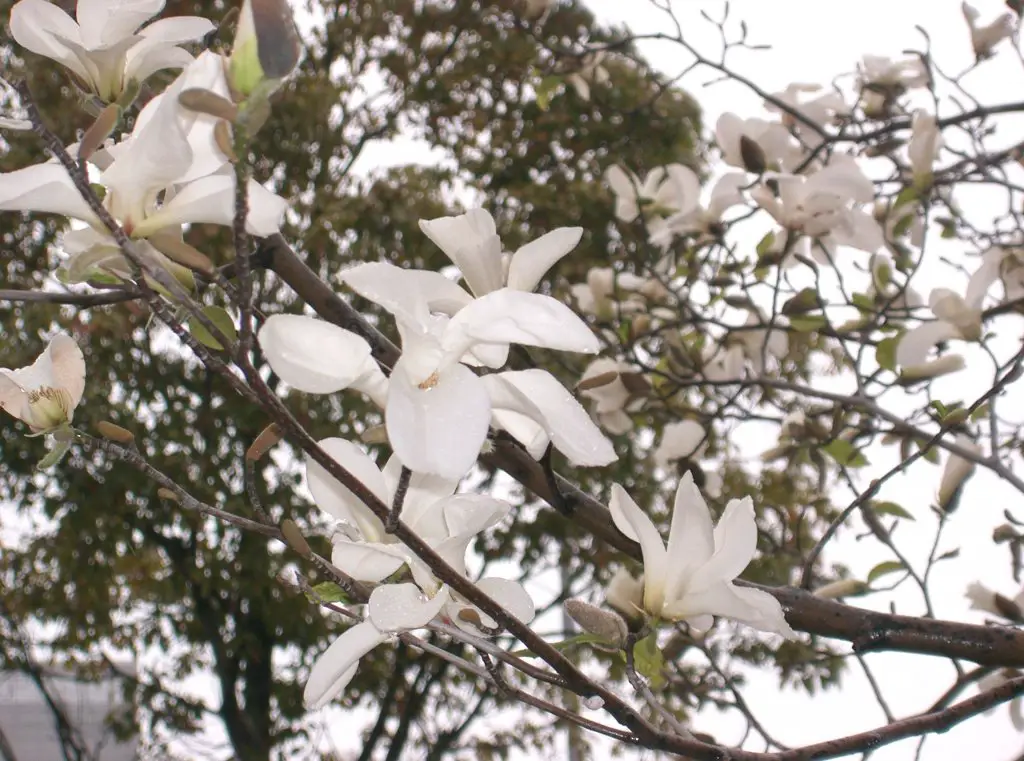Native to Japan and Korea, this slow-growing deciduous tree has fragrant flowers and soft wood. The tree usually grows between 25 and 50 feet tall and 30 feet wide. Magnolia kobus flowers and leaves are edible. The flavor of the leaves is citrusy with a hint of lavender.
Nowadays, you can find M. kobus around Europe, the Northern United States, Canada, and in numerous arboretums, botanical gardens, and nurseries.
You must have patience if you plan to grow this tree from seed. It takes around 20 years for the tree to flower completely.
Young trees flower poorly or not at all.
What Are You Foraging For Right Now?
We're thrilled to hear your ideas. What would you like to submit today? Feel free to share your thoughts and experiences with us.
Magnolia Kobus Plant Profile and Aliases
From the Magnoliaceae family, the Magnolia kobus belongs to the Yulania subgenus. A few of the common names and synonyms for this plant include:
- Mokryeon
- Kobushi
- Kobus magnolia
- Northern Japanese magnolia
- Yulania kobus
You might also hear about the M. kobus var. borealis, which is the same tree grown in Eastern Hokkaido and Northern Honshu. Grown in these environments, the plant is more robust and has larger leaves.
The Japanese magnolia is closely related to the Magnolia stellata, also known as star magnolia. The star magnolia has narrower tepals and only grows to be about 20 feet tall. It is said to be a variety of kobus.
Physical Characteristics
Starting from the bottom, the trunk of this tree is a gray-brown color. When the tree is young, it has a pyramidal shape. As it ages, it becomes denser and rounder.
The Japanese magnolia produces flowers before it produces leaves. The fragrant white flowers have a slightly pink tinge and are about 10 centimeters (four inches) in diameter. Each flower has between six and nine petals.
In the summer, the obovate-shaped leaves are dark green with a smooth underside, even edges, and a pointed tip. They are usually between three and six inches long. In fall, the leaves turn yellow and fall to the ground.
Magnolia kobus also produces fruit. The fruits have small, red seeds that attract birds.
In the dead of winter, the tree is quite bare. Once late winter or early spring rolls around, the flowers begin to bloom.

Is Magnolia Kobus Edible?
Parts of the Japanese magnolia are edible. The most palatable parts of the tree are the flowers and leaves. The seeds are not edible.
A few ways to use the flowers and leaves include:
- Cooked or raw leaves and flower buds (salad, stir fry, soup, curry, stew)
- Steeped leaves to make a tea
- Ground older leaves into a powder to use as a seasoning
- Pickled petals
- Magnolia simple syrup
- As an edible garnish on plates and desserts
The flavor of the leaves is citrusy with a hint of lavender.
What Else is Magnolia Kobus Used For?
Aside from the culinary uses, the wood of this tree is also used for multiple projects. Because it is soft, it is great for carving.
Some of the most common things that are made with this wood are:
- Utensils
- Matches
- Engraved artwork
- Medicine (the Ainu used the bark to cure common colds and headaches)
This flowering tree is especially important to farmers. It clearly indicates the beginning of spring, aka planting season.
Additionally, these trees make great hedges, privacy fences, and land borders. However, you must keep in mind their full-grown size before planting them.

How to Grow Japanese Magnolia
There are two options when growing this plant. You can grow it from propagation or seed.
1. Propagate From Cuttings
One of the best benefits of propagating a Japanese magnolia is that you do not need to wait two decades for flowers to bloom. In many cases, a propagated root will give you at least a few flowers within a few years.
- Cut a branch in the summer after the buds have set
- Cut about eight inches of the branch and immediately submerge the cut end in water
- Remove all but the upper leaves and then make a two-inch slice at the base of the cutting
- Dip the cutting in a hormone solution and place it into a small pot with rich soil
- Place a plastic bag over the cutting to keep in moisture and mist the plant often
- Leave it in indirect sunlight until roots grow, usually within a few months.
From here, you can carefully transfer it outdoors.
While propagating produces faster results, it does not always work. It is ideal to take multiple cuttings when starting this experiment.
2. Grow From Seed
If you choose to grow from seed, the process is a bit longer.
- You must collect the berries when they are bright red (ripe)
- Remove the flesh of the berries and soak the seeds overnight before cleaning them vigorously in the morning.
- It is important to keep the seeds cold during winter and sow them in late winter, preferably in a greenhouse
- The seeds will germinate in spring but may take up to a year and a half to grow.
- Until the tree reaches 15 centimeters, it should be kept inside the greenhouse and always moist.
After the first winter, you can move the tree outside.
When Should Kobushi Magnolia Trees Be Planted?
These trees have a slow enough growth rate as it is, so planting them in the correct location is vital if you would like to see them flower in your lifetime.
They are typically found in USDA hardiness zones 5-8.
Japanese magnolias prefer moist, rich, organic soil. The tree does not grow well in extremely dry or moist soil.
Additionally, while you may see some of these trees near roadways, they typically do not thrive near urban pollutants.
Plant the tree in an area where it will receive full sun and partial shade. An area with some wind protection is also ideal because the branches are brittle.
Plant Care Tips
- Do not plant the tree directly facing the south. This will cause the buds to open too early in the winter.
- Fertilizing the plant in the spring for the first three years is beneficial.
- This tree only needs about 1 inch of water per week. In general, Mother Nature usually takes care of this through rainfall and irrigation.
- Be patient with the bloom time. It could be twenty years before you see flowers.
- Do not worry about a short drought. This tree can tolerate it.
- There is no need to prune Magnolia kobus unless you are ridding it of damaged branches or unblocking a walkway.
Originally from Florida, but with a lust for travel, Sami has found herself in many remote areas with little-to-no access to traditional medicines. Since 2014, she has been experimenting with natural remedies, eastern medicine, and foraging. She believes that the Earth provides us with everything we need to live, heal, and cure.

